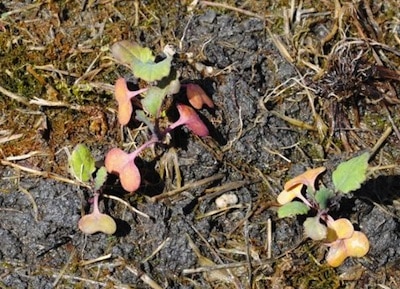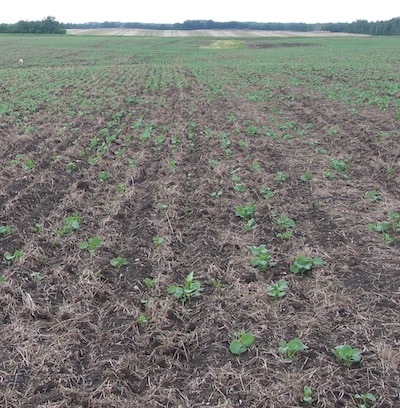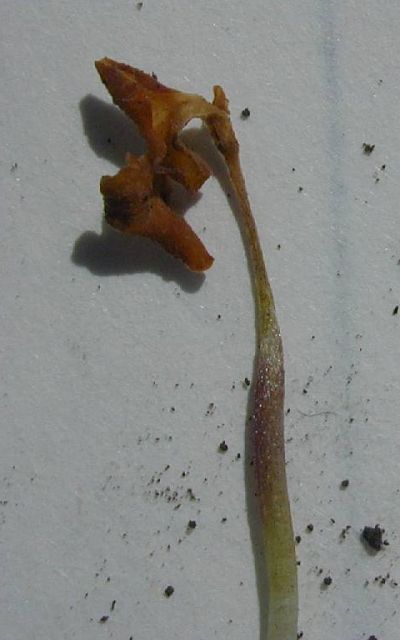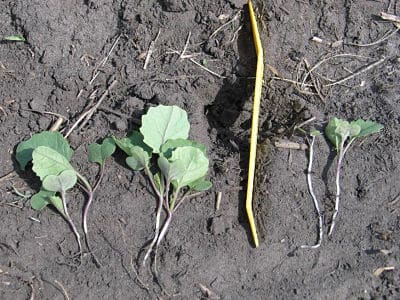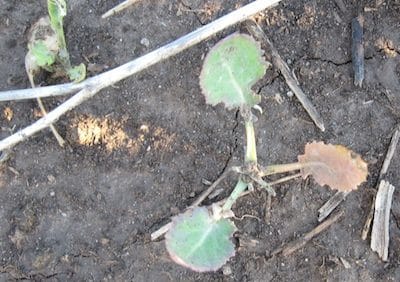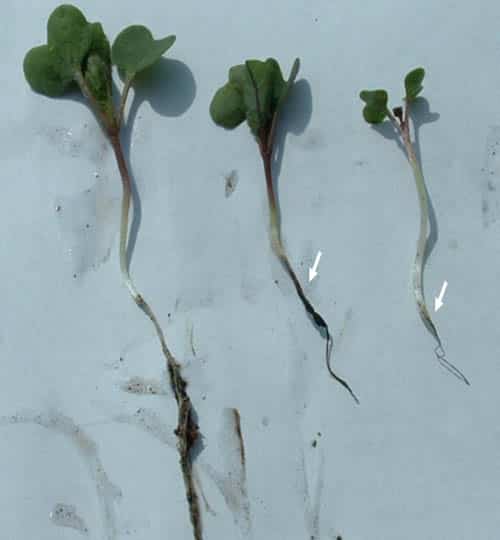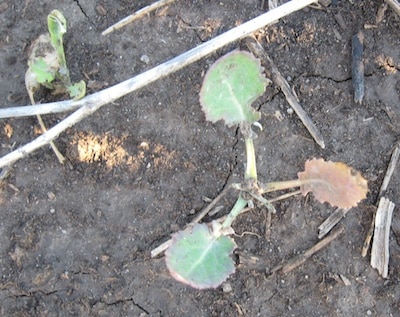
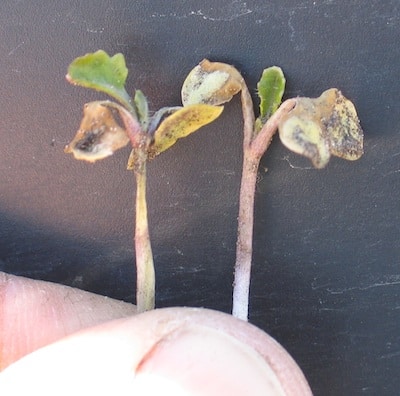
Many factors can cause a thin canola stand. Proper diagnosis is important for effective management. Here are common factors, with diagnosis tips for each. Many more photos are posted at the bottom of the article.
Herbicide carryover, if it occurs, will be most severe in areas where application rates were the highest. Field corners are a great place to look for herbicide injury symptoms because right in the corner where the sprayer makes a sharp turn, one end of the boom is going so fast, application rates would be a small fraction of normal, so injury symptoms should be minimal, while at the other end the boom will be almost stopped as the sprayer makes the turn, and rates would have been many times higher than normal. Click here and check page 58 and 59 of the guide to crop protection for a list of residual herbicides and the recropping restrictions for each.
Fertilizer toxicity. High rates of nitrogen and sulphur placed in the seed row can greatly increase mortality if the seeding equipment has low seed bed utilization (SBU). Toxicity damage often occurs in patterns, being worse in dryer or lighter parts of the field that don’t have the moisture to diffuse fertilizer concentrations beside the seed. You may also notice differences row to row if some openers are worn more than others and not providing required seed/fertilizer separation. Low moisture conditions overall will make damage worse.
Excess moisture. Flooded soils can stop root function and kill canola seedlings within a matter or days. Bottom leaves will tend to yellow first. This damage will be more common in low spots.
Frost damage. Frost can cause leaves to turn yellow or brown, then dry up and fall off. Severe frost damage can also cause pinching of the stem up near the growing point, closer to the cotyledon. Disease can also cause pinching of the stem, but disease pinching tends to occur closer to the soil surface or below the surface where the hypocotyl remains white. Regular scouting makes this diagnosis easier, especially if you know the stand looked good the day before a frost.
Wind. This year strong winds sheared off some canola seedlings and blew away the top inch of soil and the seed along with it in some areas, while burying small seedlings in others. This will create patches within a field. If winds have been heavier than usual, consider this possibility. Losses will tend to be worse on hilltops.
Seedling disease. Stem and hypocotyl (the part of the seedling’s stem below the cotyledons and down to the seed) damage near the soil surface and below is likely seedling disease. To make sure, use a magnifying glass to look at the hypocotyl to rule out insect feeding. Seedling diseases can be more common in canola seeded too deep into cool and wet soils. Because the plant takes that much longer to emerge and because the size of the vulnerable hypocotyl area is that much longer than with a shallow seeded plant, the plant is more susceptible to seedling diseases. Click here for a CanoLAB video on identifying seedling blight.
Seed quality. If the stand is spotty throughout the field, possible reasons include low quality seed, or low seeding rate. Certified No.1 treated seed bought new over the past winter or spring is unlikely to have any germination problems, but it’s always good to keep a sample just to make sure. Certified No.1 treated seed carried over on farm could lose quality, especially if given an after market treatment and then not seeded in the year the treatment was applied.
Dry seed. Seed that is very dry is more prone to cracking as it moves through the drill, which can reduce germination rates. A slower fan speed will help to reduce damage.
Seed rate. If the seed is good but the stand is spotty throughout the field, the seeding rate may have been too low. Large seed (high TKW) seeded at a low seeding rate may provide only a few plants per square foot. Proper calibration is another potential factor, especially with a new drill. Did the drill meter out the seed counts intended? It is difficult to scout for a “lack” of seeds, but look in the seed row close to plants that have emerged for any ungerminated seeds or signs of seedling mortality, to rule out other causes.
Insect damage. Cutworms and wireworms can wipe out young canola plants before emergence or shortly thereafter. Start scouting for damaged or missing plants on a weekly basis once the crop starts to come up. Cutworm feeding results in notched, wilted, dead, or cut-off plants. With wireworms and sometimes with cutworms, the plants may not emerge at all. Patterns confined to hill tops, side hills, water runs or field edges often suggests environmental, disease or insect problems.
Drill problems. Repeatable patterns in rows or groups of rows usually suggest a mechanical issue with the drill. Single rows could be plugged. Whole manifolds could have plugged feeder hoses. One wing of the drill could be bent and digging deeper. Openers behind the tractor wheels could be worn more than others and not placing seed properly. The pattern can often tell you where on the machine the problem occurred.
Seeding depth. Seeding too deep can also greatly reduce emergence rates.
In some cases we can never really know for sure the causes for a thin stand. In those cases, the best action might be to do nothing and hope the crop recovers. There is no sense spending money on a cure when you don’t know the problem.
